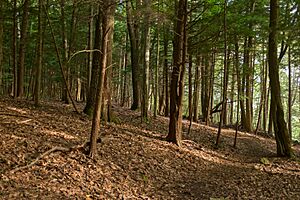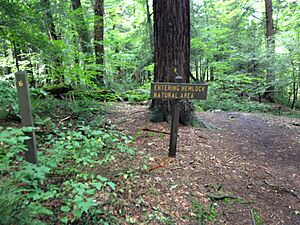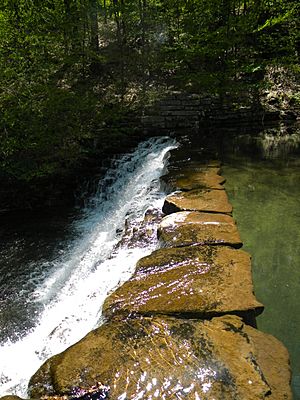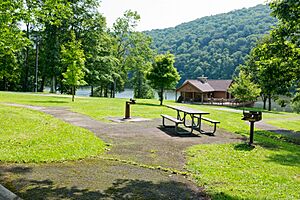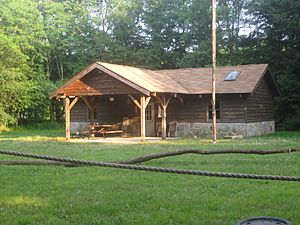Laurel Hill State Park facts for kids
Quick facts for kids Laurel Hill State Park |
|
|---|---|
|
IUCN Category III (Natural Monument)
|
|
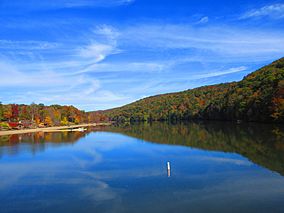
View of the lake during the autumn season.
|
|
| Location | Somerset, Pennsylvania, United States |
| Area | 3,935 acres (15.92 km2) |
| Elevation | 2,316 ft (706 m) |
| Established | October 1945 |
| Governing body | Pennsylvania Department of Conservation and Natural Resources |
| Website | Laurel Hill State Park |
|
Laurel Hill RDA
|
|
| Lua error in Module:Location_map at line 420: attempt to index field 'wikibase' (a nil value). | |
| Location | 4 mi. W of New Centerville and PA 281, Somerset, Pennsylvania |
| Area | 1,352 acres (547 ha) |
| Built | 1935 |
| Built by | Civilian Conservation Corps |
| Architectural style | Rustic style |
| MPS | Emergency Conservation Work (ECW) Architecture in Pennsylvania State Parks: 1933-1942, TR |
| NRHP reference No. | 87000738 |
| Added to NRHP | May 18, 1987 |
Laurel Hill State Park is a huge park in Pennsylvania. It covers about 3,935 acres! This park is located in Somerset County. It's famous for Laurel Hill Lake, a 63-acre man-made lake. Young men from the Civilian Conservation Corps (CCC) built this lake during the Great Depression. Laurel Hill State Park is easy to find. It is about 8 miles from Interstate 76. You can also reach it from Pennsylvania Route 31 or Pennsylvania Route 653.
Contents
History of Laurel Hill Park
The Lumber Era
For a long time, the Laurel Hill Valley was untouched. But in 1886, the lumber boom reached this area. Lumbermen cut down almost all the old, tall forests. They took trees like hemlock and white pine. These trees were used for lumber or to support coal mine shafts. The bark of hemlock trees was used to make leather.
After the lumbermen left, they only left behind tree tops. These dry tree tops often caught fire from passing trains. Huge wildfires swept through the mountains. This left the Laurel Hill area looking like a wasteland. The forests struggled to grow back. The hills started to erode, and streams began to dry up. There was very little wildlife left.
In 1987, the Laurel Hill RDA was recognized as a national historic district. This means it's an important historical area.
How the Forests Grew Back
Today, the area around Laurel Hill State Park looks very different. It's no longer a wasteland. It's a thriving second growth forest. Many different kinds of wildlife now live here. This amazing change happened because of the hard work of men from the Works Progress Administration (WPA) and the Civilian Conservation Corps (CCC). They worked during the Great Depression.
In 1935, the government bought this stripped forest land. This was part of President Franklin D. Roosevelt's New Deal plan. The men from the WPA and CCC started working on July 1, 1935. They cleared tangled brush from streams and forests. They built bridges, cleared paths, and planted new trees. They also built many of the buildings and facilities you see at the park today. For example, they built the dam on Laurel Hill Lake. They also built the large group camping areas.
In 1945, the park officially opened. The United States government gave ownership of the area to Pennsylvania.
Fun Activities at Laurel Hill
The Hemlock Trail
When the lumbermen cut down trees, they missed some. These were on very steep ground above Laurel Hill Creek. These are the only original, untouched trees left. The Hemlock Trail now goes through this ancient forest. You can find the trail from Buck Run Road or from the head of the lake.
Hunting in the Park
You can go hunting in about 2,100 acres of Laurel Hill State Park. Some common animals hunted here are rabbits, pheasants, raccoons, squirrels, turkeys, and white-tailed deer. However, you are not allowed to hunt groundhogs. Hunters must follow the rules set by the Pennsylvania Game Commission.
Every September, you can hunt Canada geese at the park. This helps control the goose population. Too many geese can cause problems. Their droppings can pollute the water and beaches.
Fishing and Boating
Laurel Hill Creek and Jones Mill Run are great for fishing. They are stocked with trout. You can also find native brook trout there. Laurel Hill Lake has many types of fish. These include trout, catfish, sunfish, perch, crappie, bluegill, and bass.
You cannot use gasoline-powered boats on Laurel Hill Lake. You can use non-powered boats, like canoes or kayaks. Electric-powered boats are also allowed. All boats must be registered with any state.
Swimming at the Beach
The beach at Laurel Hill State Park is open every day. It opens in late May and closes in mid-September. The beach opens at 8:00 AM and closes at sunset.
Picnic Areas
Laurel Hill State Park has three picnic areas.
- Picnic area #1 has a playground, a ballfield, and horseshoe pits.
- Picnic area #3 is close to the beach and also has a playground.
- Picnic area #4 is near the boat launch.
There is no picnic area #2.
Winter Fun
When it snows, the park offers lots of winter activities. There are 10 miles of snowmobile trails. These trails connect to 60 miles of trails in Forbes State Forest. Laurel Hill Lake is open for ice fishing and ice boating. The park also has 20 miles of trails for cross-country skiing.
Staying Overnight
Laurel Hill State Park has several ways for you to stay overnight.
Campground
The campground has 262 sites for tent or trailer camping. Many of these sites have electricity. The campground has modern restrooms with flush toilets and showers. There is also drinking water and two places to dump waste. You can even rent a walled tent. It sleeps up to six people and has a refrigerator and bunk beds.
Cottages
There are eight cottages you can rent. Each cottage has electric lights, outlets, and a heater. They can sleep up to five people. They have wooden floors, glass windows, and a screened-in porch. Outside, each cottage has a picnic table and a fire ring.
Group Tenting
There is a large area for organized groups to tent camp. This area is open all year. Groups need to follow some rules:
- 1. All groups must give a list of names to the park office.
- 2. Fires can only be built in special fire areas.
- 3. You cannot cut down any standing trees.
- 4. Trailers are not allowed in the group tenting area.
Cabins for Groups
The cabins built by the CCC are still used today. Large, non-profit groups can rent them. There are six group cabin areas. They are open from mid-April to mid-October. Each area has a central shower house with flush toilets. They also have a large dining hall with a kitchen.
Laurel Hill Lodge
Laurel Hill Lodge is a modern, two-story building. It has a big fireplace and high ceilings. There's a private deck that looks out over the park and Laurel Mountain. The lodge is great for winter visits. It has racks for skis and snowboards. It also has places to dry gloves and boots. There are five bedrooms that can sleep up to 14 people. It has three bathrooms, one and a half kitchens, a recreation room, and laundry facilities.
Boy Scout Camps
There are two Boy Scout camps inside the state park. They are run by the Westmoreland-Fayette Council. These camps are Camp Conestoga and Camp Buck Run.
Nearby State Parks
Here are some other state parks within 30 miles of Laurel Hill State Park:
- Casselman River State Park (Maryland)
- Keystone State Park (Westmoreland County)
- Kooser State Park (Somerset County)
- Laurel Mountain State Park (Westmoreland County)
- Laurel Ridge State Park (Cambria, Fayette, Somerset, and Westmoreland counties)
- Laurel Summit State Park (Westmoreland County)
- Linn Run State Park (Westmoreland County)
- New Germany State Park (Maryland)
- Ohiopyle State Park (Fayette County)
Images for kids


